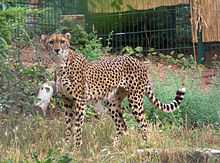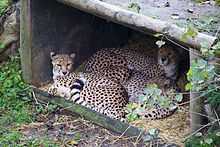Sudan cheetah
| Sudan cheetah | |
|---|---|
 | |
| A female Sudan cheetah in Zoo Landau, Germany. | |
| Conservation status | |
| Scientific classification | |
| Kingdom: | Animalia |
| Phylum: | Chordata |
| Class: | Mammalia |
| Order: | Carnivora |
| Family: | Felidae |
| Genus: | Acinonyx |
| Species: | A. jubatus |
| Subspecies: | A. j. soemmeringii |
| Trinomial name | |
| Acinonyx jubatus soemmeringii (Fitzinger, 1855) | |
| Synonyms | |
|
Acinonyx jubatus megabalica | |
The Sudan cheetah[1] (Acinonyx jubatus soemmeringii) is a cheetah subspecies from Central and Northeast Africa. It occurs in Sudan, Ethiopia, Somalia and the Central African Republic. It is also commonly known as Somali cheetah,[2] Northeast African cheetah or Central African cheetah.
Since 2002, it is listed as Vulnerable by IUCN. The Sudan cheetah population was estimated at less than 2,000 cheetahs in the wild.[3] The population is still increasing slowly due to conservation efforts and breeding programs in Europe and the Middle East.
Once thought to be genetically identical to other sub-saharan cheetahs, it has been revealed that the Sudan cheetah is a distinct subspecies after being separated from their Southern African relative between 16,000 and 72,000 years ago.[4][5]
Taxonomy
In 1855, the Austrian zoologist Leopold Fitzinger proposed the trinomen Acinonyx jubatus soemmeringii for the cheetah subspecies living in Northeast and Central Africa, naming the species after German physicist Samuel Thomas von Soemmerring. The subspecies may also be respectively known as "Soemmerring's cheetah".
Following Fitzinger's trinomen for the Sudanese cheetahs, other zoologists proposed two more trinomen for the Northern African cheetah (Acinonyx jubatus megabalica and Acinonyx jubatus wagneri), however, they were nominated as different subspecies living in specific areas of Sudan. They are not recognized as subspecies, therefore are considered as synonyms for the Sudan cheetah (Acinonyx jubatus soemmeringii).
Physical characteristics

Cheetahs are the fastest land animal alive. They are capable of reaching speeds of up to 75 miles an hour as they hunt for food and able to go from 0 to 65 mph in three seconds.
The Sudan cheetah, along with the Tanzanian cheetah, rank among the largest subspecies. However, it is the darkest in fur color. It has a densely tawny spotted coat with relatively thick and coarse fur in comparison to its relatives from eastern and northwestern Africa. The tear marks of the Sudan cheetah are highly inconsistent, but they are frequently thickest at the mouth corners than the other four subspecies, making them quite unique. This subspecies do not have mustache markings. The belly of the Sudan cheetah is distinctly white while its breast and throat can have some spotting similar to the eastern subspecies. This cheetah has distinct white patches around its eyes but the facial spotting can vary from very dense to relatively thin. This subspecies has been seen with both white and black tipped tails. This subspecies' tail is also notably thick.
The Sudan cheetah is the only subspecies not being reported to show a rare color variation. However, despite having the darkest fur color, a few Sudan cheetahs appear to be paler than usual.
Habitat and population
Cheetahs live in wide open lands, savannahs, grasslands, semi-arid areas, mountainous regions and other open habitats where there is a large density of preys.
The Sudan cheetah population have lower density in their countries, unlike their eastern and southern cousins who are the most common, whilst the Northwest African and Asiatic cheetahs are listed as critically endangered. It is known there is the estimated total population of 2,000 Sudan cheetahs in the wild, and there are apparently more in Ethiopia.[6] Other than those countries, the Northeast African cheetahs have been found in eastern parts of Nigeria, Niger, Cameroon, Chad, Eritrea, Djibouti, northern Somalia, Libya and Egypt, where the subspecies might even shared borders with Northwest African and Tanzanian cheetahs. However, currently in the 21st century, the cheetah subspecies are thought to be regionally extinct in Nigeria, Libya and Egypt. There is lower density in their current locations in other countries. The cheetahs are rarely seen in northern regions of Sudan, today they occur mostly on South Sudan. Wild cheetahs have been spotted in An Nil al Azraq, in the southeast region of South Sudan.
The Sudan cheetah can be seen in various national parks and reserves, such as Manovo-Gounda St. Floris National Park, the Boma National Park and the Gambela National Park.
Prey
The Sudan cheetahs are carnivorous and mostly feed on herbivore mammals, such as Grant's gazelles, hares, guineafowls and large mammals like zebras and ostriches on few occasions.
History
Tamed cheetahs
.jpg)
Both continents of Africa and Asia had 100,000 cheetahs in the 19th century. Sudan cheetahs were once numerous in north, central and in the Horn of Africa. They ranged in Egypt, Libya on northern Africa, from Somalia to Niger on eastern and central Africa. Cheetahs are known to be tamed, trained and to hunt herbivorous animals. Once existed in Egypt, the Ancient Egyptians often kept the cheetahs and raised them as pets, and also tamed and trained them for hunting mammals. Tamed cheetahs were taken to open hunting fields in low-sided carts or by horseback, hooded and blindfolded, and kept on leashes. When the prey was near enough, the cheetahs would be released to go after it.
This was the Egyptian tradition that was later passed on to the ancient Persians and brought to India, where the practice with Asiatic cheetahs was continued by Indian princes into the 12th century.
Evolutionary history
The closest relative of the Sudan cheetah is the South African cheetah (Acinonyx jubatus jubatus). It was unknown whether or not the subspecies from Sudan is genetically different from other cheetah population from other African regions and Iran to deserve their status as a separate subspecies. It has been revealed that the Northeast African cheetahs to be a completely distinct subspecies in January 2011, having been diverged from their Southern African cousins between 16,000 and 72,000 years ago, therefore is distinguish from their closest neighbors from Iran, the Asiatic cheetahs (Acinonyx jubatus venaticus).[4][5]
Threat
Like other species, the Sudan cheetahs are threaten by illegal wildlife trade, hunting, poaching, habitat loss and lack of prey which reduces their numbers, making them hard and rare to spot them in the wild.[7] These animals can be highly threaten by other predators such as lions, leopards and hyenas, as they could kill the cheetahs or steal their food. Cheetah cubs can be sold on the black market for over $1,000 but rescuing a single cub costs over three times that much, and the majority of captive cheetah cubs may die before they ever leave Africa. Though it is known that there are an increasing rate of Northeast African cheetah cubs mostly from Somalia being traded into the Middle East.[8] Fortunately, captive breeding projects in Europe and in the Middle East are slowly increasing their numbers and have been successful so far.
Conservation

The Sudan cheetah is currently listed as vulnerable in the IUCN Red List of Threatened Animals. There are breeding programs from Europe and the Middle East for the Sudan cheetah, such as the European Endangered Species Programme (EEP) which is reserved for European Association of Zoos and Aquaria (EAZA). The breeding programs have been successful so far.[9]
Rewilding project in Arabia
There is also a rewilding project from the Breeding Centre for Endangered Arabian Wildlife for the Sudan cheetahs breeding in wildlife parks and those in captivity in the Middle East, such as in the Arabian Wildlife Park from Sir Bani Yas, the Al Ain Zoo, the Emirates Park Zoo and Sharjah's Arabian Wildlife Center from the United Arab Emirates.[10][11]
Cheetahs once lived in the Arabian Peninsula until they became regionally instinct everywhere in the wild of the Middle East in the early 1970s. The rewilding project officially started in 2008, when four captive-born Sudan cheetahs have been reintroduced into the wild of Sir Bani Yas Island to roam free and maintain natural balance. The cheetahs are taught to breed, to survive and feed on goitered and mountain gazelle on their own, then their offsprings would successfully learn those instincts from their parents.[12]
Cheetahs are known to be difficult to breed and therefore, the survival rate of cheetah cubs are low in the wild and in captivity. However, the project has been successful so far. In April 2010, the first four Sudan cheetah cubs have been born on the island from a successfully rewilded Sudan cheetah mother named Safira. According to conservation team, the cubs' mother have done an impressive job in taking care of her children. The cubs are recognized to be the first wild-born cheetahs to ever been born in Arabia after 40 years ago.[13][14][15][16]
The Al Wabra Wildlife Preservation (AWWP) from Qatar and the Wadi Al Safa Wildlife Centre from Dubai are also part of the international breeding program to help save the rare Sudan cheetah population which are breeding in captivity. The breeding programs of the Middle East are aiming to release the Sudan cheetah into the wild of Africa. There are currently 23 adult and 7 cubs in Wadi Al Safa.[2][17]
In captivity

Cheetahs are known to be difficult to breed, especially in captivity. Like the South African cheetah, the Sudan cheetah has been breeding in captivity for many years mostly in European zoos, such as Chester, Tierpark Berlin, Landau, Whipsnade, Cerza and La Palmyre Zoo from Germany, United Kingdom and France. There is also a few cheetahs in the Fota Wildlife Park.
In Ireland, Sudan cheetahs have been captive in Dublin zoo since 1970s, until two last cheetahs managed to escape the zoo since August 1990. The second was shot dead five times at close ranges, while the young viewers witnessed such tragic event.[18]
In 2010, four cheetahs from Dublin zoo have been exchanged for Asian elephants from India's Mysore Zoo.
See also
Sir Bani Yas, United Arab Emirates
References
- ↑ Murray Wrobel. "Elsevier's Dictionary of Mammals". Retrieved 13 February 2015.
- ↑ 2.0 2.1 "Al Wabra Wildlife Preservation (AWWP)". Retrieved 14 March 2015.
- ↑ "Cheetah, Acinonyx jubatus". Retrieved 4 February 2015.
- ↑ 4.0 4.1 Ella Davies (24 January 2011). "Iran's endangered cheetahs are a unique subspecies". Retrieved 4 February 2015.
- ↑ 5.0 5.1 Three distinct cheetah populations, but Iran's on the brink, 18 January 2011, retrieved 4 February 2015
- ↑ "Past and present cheetah range map.". Cheetah.org. Retrieved 7 February 2015.
- ↑ "Friedman Cheetah Conservation Grants Program". Panthera.org. Retrieved 6 April 2015.
- ↑ "Acinonyx jubatus (Cheetah, Hunting Leopard)". IUCNRedList.org. Retrieved 7 February 2015.
- ↑ "Captive breeding of North African cheetah, Acinonyx jubatus soemmeringii". September 2006. Retrieved 4 February 2015.
- ↑ Rayeesa Absal (6 April 2010). "Birth of four cubs signals return of cheetah to UAE". GulfNews.com. Retrieved 4 February 2015.
- ↑ Binsal Abdul Kader (1 January 2011). "Rewilding of Cheetahs a big success in Sir Baniyas Island". GulfNews.com. Retrieved 4 February 2015.
- ↑ John Henzell (22 February 2010). "Survival instinct kicks in for Sir Bani Yas cheetahs". TheNational.ae. Retrieved 15 February 2015.
- ↑ "First wild born cheetah for 40 years in Arabia". WildlifeExtra.com. Retrieved 15 February 2015.
- ↑ "Sir Bani Yas Island nature reserve is an ‘Arabian Ark’". News.com.au. 13 February 2015. Retrieved 15 February 2015.
- ↑ "The Northern Cheetah finds a new home on Sir Bani Yas Island". SirBaniYasIsland.com. 15 April 2010. Retrieved 15 February 2015.
- ↑ Andy Sambidge (5 April 2010). "Baby cheetahs born on Abu Dhabi island". HotelierMiddleEast.com. Retrieved 6 April 2015.
- ↑ Colin Simpson (29 July 2012). "Wildlife centres in UAE toast births of cheetahs". TheNational.ae. Retrieved 14 March 2015.
- ↑ dfallon (13 January 2013). "Some great Dublin Zoo escapes.". ComeHereToMe.com. Retrieved 4 February 2015.
External links
| Wikimedia Commons has media related to Acinonyx jubatus soemmeringii. |
